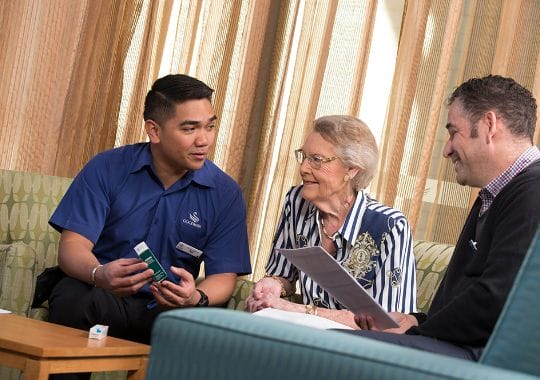
Goodwin has pioneered Australian-first research into a pharmacist placement in residential aged care, which has potential to improve resident’s quality of life through reducing over-medication and drug-related hospitalisations among other benefits.
The trial is the latest instalment in Goodwin Aged Care Services’ work towards a restraint-free philosophy of care.
The research pilot project was a partnership with the University of Canberra, Discipline of Pharmacy, Faculty of Health and funded by Goodwin.
A reduction of hospitalisations, drug related issues, and time spent on medications rounds are some of the key outcomes to emerge from the trial.
‘Goodwin is committed to research and translating evidence into practice in the clinical setting,’ CEO Sue Levy, told Australian Ageing Agenda magazine for a feature article in May.
The pharmacist pilot feasibility study investigated integrating a clinical pharmacist into a residential aged care facility to improve the quality administration of medicines. The three key areas the project aimed to address were:
The residential care pharmacist trial is one of several research projects and trials underway at Goodwin towards fulfilling its key philosophy for residents to be restraint-free.
Restraint includes:
‘We have to improve residents’ quality of life, as a whole industry,’ says Goodwin Executive Manager Residential Care, Robyn Boyd.
In 2014 Goodwin began a program of review and removal of all forms of restraint, starting with the physical. The use of physical restraints is down from 57 at the start of the program to only two residents now using bedrails, and those are at residents’ request.
The next and current focus is chemical restraint, which is where the research partnerships come in.
In 2014-15 Goodwin partnered with University of Tasmania on their RedUSe program aimed at reducing the use of benzodiazepines and anti-psychotics in aged care. During this program, one Goodwin facility was able to reduce the number of residents on these medications from 18 to one.
Since 2016, Goodwin has partnered with Churchill Fellowship recipient Dr Moyra Mortby, originally at the Australian National University, on a four-year ARC-funded research project into increasing non-pharmacological interventions to manage the behavioural and psychological symptoms of dementia (BPSD).
“Often a behavioural outburst by a resident living with dementia is a call for help for an underlying problem they can’t communicate, such as hunger, thirst, pain or restlessness,” Ms Boyd says.
The research project aims to reduce the reliance on benzodiazepines and anti-psychotic drugs by training care staff to first identify and assess the residents’ unmet needs, potentially resolving the situation without pharmaceuticals.
By implementing lessons learned from these projects, Goodwin now follows a new policy that sees the nurse practitioner notified every time a resident is prescribed a benzodiazepine or anti-psychotic. It aims to guide the resident on a program to cease the medication within 12 weeks.
‘It is important to challenge the current landscape of medicines use in facilities in light of an ageing population, increasing co-morbidities and the changing care requirement,’ says Ms Levy.
‘The clinical, operational and economic evidence gained from the pharmacist placement study will be useful to inform whether the integration of a Residential Care Pharmacist into aged care facilities is feasible, and may inform potential government or private industry funding models to support the role of the Residential Care Pharmacist as part of the clinical team within facilities.’
